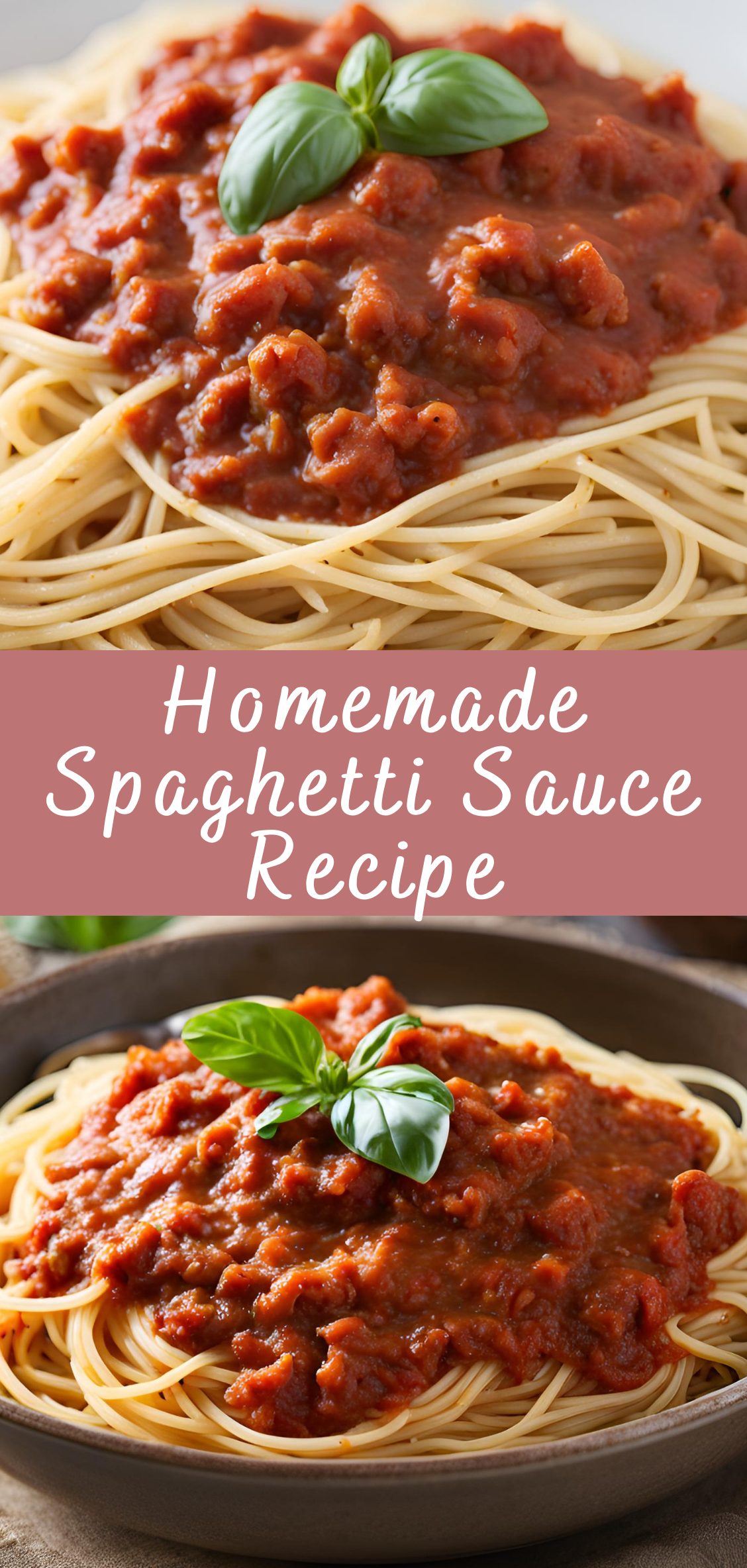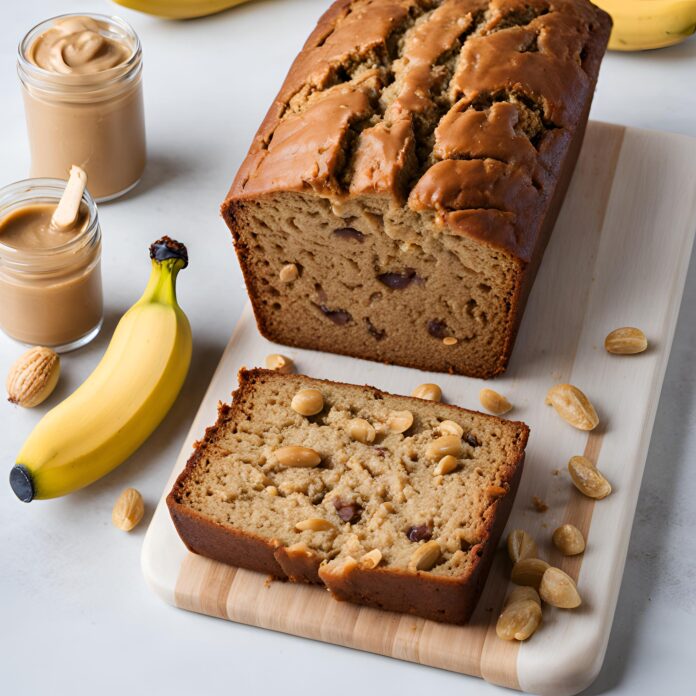Homemade Spaghetti Sauce Recipe
This Homemade Spaghetti Sauce is a classic, rich, and hearty recipe that’s perfect for pasta lovers. Packed with tomatoes, garlic, herbs, and a touch of olive oil, this sauce has a depth of flavor that makes it far superior to store-bought versions. It’s simple to make and can be easily customized to suit your taste, whether you prefer a chunky sauce or a smoother version.

Instructions:
1. Heat the Olive Oil:
- In a large pot or Dutch oven, heat the olive oil over medium heat. Add the chopped onions and sauté until they become soft and translucent, about 5-7 minutes.
2. Add the Garlic:
- Stir in the minced garlic and cook for an additional 1-2 minutes until fragrant. Be careful not to burn the garlic, as it can become bitter.
3. Incorporate the Tomatoes:
- Add the crushed tomatoes, tomato sauce, and tomato paste to the pot. Stir to combine everything together, ensuring the tomato paste is well distributed.
4. Season the Sauce:
- Add the dried oregano, dried basil, sugar, salt, black pepper, red pepper flakes (if using), and bay leaves. Stir well to incorporate the seasonings into the sauce.
5. Optional Add-ins for Flavor:
- If you’re using balsamic vinegar or red wine, add it now. These ingredients add a rich depth of flavor to the sauce. Stir well and allow the sauce to come to a simmer.
6. Simmer the Sauce:
- Reduce the heat to low and let the sauce simmer gently for at least 30 minutes. For best results, simmer for 1-2 hours, stirring occasionally to prevent sticking or burning. The longer the sauce simmers, the richer the flavor becomes.
7. Remove Bay Leaves and Adjust Seasoning:
- After simmering, remove the bay leaves from the sauce. Taste and adjust the seasoning as needed—adding more salt, pepper, or sugar to balance out the flavors.
8. Serve and Garnish:
- Remove the sauce from heat and discard the bay leaves. Serve over your favorite pasta, and garnish with fresh basil or parsley.
Tips for the Best Homemade Spaghetti Sauce:
- Use Quality Tomatoes:
- Opt for high-quality canned tomatoes such as San Marzano. These tomatoes are sweeter and less acidic, contributing to a better-tasting sauce.
- Simmer for Depth:
- The key to a flavorful spaghetti sauce is allowing it to simmer for an extended period. This helps the flavors meld together and creates a rich, complex sauce.
- Add Vegetables:
- For extra nutrition and flavor, you can add chopped vegetables like bell peppers, carrots, or mushrooms. Sauté them with the onions for a heartier sauce.
- Use Fresh Herbs:
- Fresh herbs like basil and parsley elevate the flavor of the sauce. Add fresh herbs towards the end of the cooking process for the best flavor.
- Freeze for Later:
- This sauce freezes well. Store any leftovers in airtight containers or freezer bags for up to 3 months. Thaw and reheat on the stove for a quick and easy meal.
Variations:
- Meat Sauce:
- Brown 1 pound of ground beef, Italian sausage, or a combination of both, and add it to the sauce. Cook the meat with the onions for a heartier, more filling sauce.
- Vegetable Spaghetti Sauce:
- For a vegetarian version, sauté zucchini, carrots, or spinach with the onions and garlic for a nutrient-packed sauce.
- Spicy Marinara:
- Add more red pepper flakes or a dash of cayenne pepper for a spicy kick to your spaghetti sauce.
- Creamy Tomato Sauce:
- For a creamy variation, stir in ½ cup of heavy cream or mascarpone cheese towards the end of cooking for a rich, velvety sauce.
Nutritional Information (per serving):
- Calories: 120
- Fat: 6g
- Carbohydrates: 16g
- Protein: 3g
- Sodium: 580mg
- Fiber: 4g
Frequently Asked Questions:
1. How can I make my sauce smoother?
- If you prefer a smooth sauce, you can use an immersion blender to puree the sauce directly in the pot or transfer it to a regular blender in batches.
2. Can I make this sauce ahead of time?
- Yes! Spaghetti sauce tastes even better the next day. Make it a day ahead and refrigerate. It can be stored in the fridge for up to 5 days or frozen for up to 3 months.
3. How do I reduce the acidity of the sauce?
- Adding a small amount of sugar or grated carrot helps balance out the acidity of the tomatoes. Balsamic vinegar also adds a sweet depth that can help.
4. Can I use fresh tomatoes?
- Yes, you can use fresh tomatoes. Blanch them in boiling water, peel off the skins, and crush them before using. You may need to simmer the sauce longer to reduce the liquid.
Conclusion:
Making Homemade Spaghetti Sauce is simple and rewarding. With just a few pantry staples, you can create a flavorful, rich sauce that’s perfect for pairing with pasta, lasagna, or even as a base for pizza. Whether you like it smooth or chunky, this recipe is easy to customize and can be made in large batches for future meals. Enjoy the satisfaction of making your own spaghetti sauce from scratch—it’s a surefire way to elevate any pasta dish!
Homemade Spaghetti Sauce Recipe

Ingredients
- 2 tablespoons olive oil
- 1 medium onion, finely chopped
- 4 cloves garlic, minced
- 1 pound ground beef or Italian sausage (optional)
- 1 can (28 ounces) crushed tomatoes
- 1 can (15 ounces) tomato sauce
- 1 can (6 ounces) tomato paste
- 1/2 cup water (adjust as needed for desired consistency)
- 2 tablespoons sugar
- 1 teaspoon dried basil
- 1 teaspoon dried oregano
- 1/2 teaspoon dried thyme
- 1/2 teaspoon dried parsley
- 1/4 teaspoon crushed red pepper flakes (optional for a bit of heat)
- Salt and pepper to taste
- 2 tablespoons fresh basil, chopped (optional, for garnish)
- Grated Parmesan cheese (optional, for serving)
Instructions
- Heat the Oil:
In a large pot, heat the olive oil over medium heat. - Sauté Onion and Garlic:
Add the chopped onion and cook for about 3-4 minutes until softened. Then add the minced garlic and cook for another 1 minute, stirring frequently to prevent burning. - Brown the Meat (optional):
If you're using ground beef or Italian sausage, add it to the pot with the onions and garlic. Cook, breaking the meat apart with a spoon, until browned and fully cooked, about 5-7 minutes. Drain excess fat if necessary. - Add Tomato Ingredients:
Stir in the crushed tomatoes, tomato sauce, and tomato paste. Mix everything well. - Add Seasonings:
Stir in the water, sugar, dried basil, oregano, thyme, parsley, and red pepper flakes (if using). Season with salt and pepper to taste. - Simmer the Sauce:
Bring the sauce to a simmer, then reduce the heat to low. Cover the pot and let it cook gently for 45 minutes to 1 hour, stirring occasionally to prevent sticking. The sauce should thicken and the flavors will meld together beautifully. - Adjust Consistency:
If the sauce becomes too thick, add a little more water until you reach your desired consistency. - Taste and Adjust:
Taste the sauce and adjust seasonings if needed. Add more salt, pepper, or sugar to balance the flavors. - Serve:
Serve the sauce over cooked spaghetti or your favorite pasta. Garnish with fresh basil and grated Parmesan cheese, if desired.



